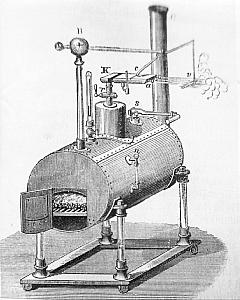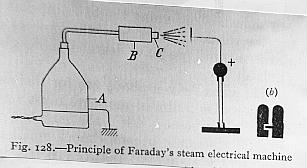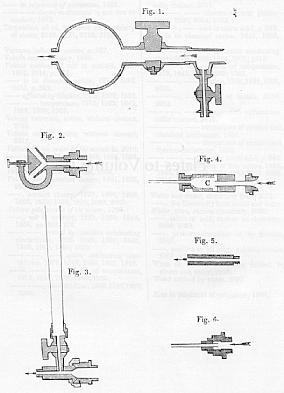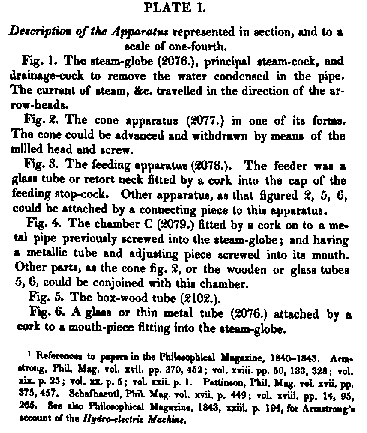
STEAM ELECTRICITY
Towards the end of the eighteenth century the evolution of electricity during the evaporation of liquids was investigated.
Apart from a burst of interest in the mid-nineteenth century no further interest seems to have been shown until the more recent researches into Volcanic Lightning after the emergence of Surtsey.
Laplace and Lavoisier in 1782 made a series of experiments in which dilute acids were poured on to iron filings or chalk with the consequent evolution of gas and the production of negative electric sparks.
They next tried `combustion experiments` and filled small dishes with burning charcoal. An electrometer connected to a dish registered negative electricity.
Volta was in Paris when Laplace and Lavoisier were carrying out these investigations. He set up three iron furnaces and threw water on them. He found both polarities of electricity were produced.
Subsequently he stated that negative electricity was produced by the evaporation of water.
On November 22nd 1784 Lichtenberg wrote to Franz Ferdinand Wolff and told him that Volta had been staying with him and set out to demonstrate to him the production of electricity from evaporating water. `Nothing happened. Volta was reduced to cursing in various languages - with no improvement`.
Horace Benedict de Saussure (1786) The results published by Volta fired up de Saussure`s enthusiasm to investigate electricity from evaporation.
His first experiment involved throwing red hot iron into an insulated coffee pot containing water. His results were opposite to those obtained by Volta. So, de Saussure rea-arranged his apparatus to allow water to be evaporated by boiling in an insulated dish. Negative electricity was usually produced but variation of polarity did occur.
Next he threw water into a dish `whose temperature was diminishing` (ie cooling). An iron `grenade` was heated to white heat and he threw water inside. A flame issued from inside the grenade!
A sheet of linen six feet square was wetted, insulated with silk cords and hung up to dry in front of a fire. A large iron plate was placed on the ground and heated so that a great quantity of steam came off.
Horace de Saussure`s results in summary are:-
1.Evaporation of water without ebullition does not produce electricity.
2.Water remaining stationary in a very hot dish (Leidenfrost`s Phenomenon) does not produce electricity.
3.Water which wets a warm surface and evaporates quietly does not produce electricity.
4.The greatest quantity of electricity is produced when the evaporating water in making the loudest noise.
5.The electrical polarity for water evaporating from heated iron or copper dish is positive. It is negative from a silver or porcelain dish.
6.Experiments to produce electricity from combustion yielded no electricity.
Lord William G. Armstrong (1840) At Cramlington Colliery, Sedgehill, Newcastle on Tyne (Northumberland, England) high pressure steam broke through the cement around the safety valve of a locomotive boiler. The Engine-Man held a shovel in the steam and with a penknife in his other hand, held about 3/8 inch from the boiler, produced electric sparks. He passed a hand through the steam and drew what he described as fire.
There are accounts of the Engine-Man entertaining his mates - which no doubt attracted the attentions of the powers that be!
Armstrong who in part is remembered as a millionaire arms manufacturer (He had built Cragside, now a National Trust property, which was one of, if not the first, house to be lit by electricity generated by turbines in streams in the gardens. In passing call to mind that Joseph Swann demonstrated his filament lamp in Newcastle). Anyway - Armstrong began an intensive investigation of the Cramlington Colliery Engine and its `Steam Electricity`.
To try and locate the source of the electric charge and relate it to the quantity of steam he made a series of brass steam cocks fitted into glass tubes. He found 4 inch long sparks were produced as steam issued from the locomotive boiler.
In the dark corona was seen around the brass steam fittings. Small sparks could be drawn from a rod held into the steam cloud collecting under the roof of the engine shed. Armstrong tried to discover if precipitation occurred comparable to that of an atomspheric thunderstorm and found some did while the rod held into the steam remained insulated. When damp affected the insulation the precipitation stopped.
Convinced the electricity was not produced by the expansion of steam he had probes inserted into the boiler and proved that electrification did not occur inside.
Only when steam issued from the jet was electricity produced.
He was mystified by the fact that steam was electrically positive but the negative could not be located anywhere on the apparatus.
Whether it was the business man or scientific curiosity or both Lord Armstrong as it were reproduced the Cramlington Colliery boiler in a version he called The Hydro-Electric Generator.

The boiler is insulated on glass legs and has an elaborate series of steam escape jets.
One of these still exists in the Newcastle Museum. The one in the Royal Polytechnic Institution is described in Noad`s Electricity and quoted by Pepper as being a cylinder boiler of 5/8inch boiler plate, 7feet 6inches long (2metres approximately) by 3feet 6 inches diameter (about 1 m). Its glass legs were 3.5 inches diameter and 3 feet long. Steam pressure 60 lbs per square inch - Spark length 22 inches.
H.L.Pattinson 1840 investigated electricity produced by steam exhausting from locomotive boilers - `immediately coming into the station with passengers` or `lifted on to blocks of dry wood.`
His results summarised:-
1. The length of the spark is proportional to steam pressure - 4 inch sparks at 52 lbs per square inch to barely perceptible at 5 lbs per square inch.
2.The atmosphere of the engine shed became charged positive.
3.In a repeat of Volta`s experiment a hot cinder placed on the cap of a gold leaf electroscope and water dropped on it produced negative electricity. Repeated on a large scale with an iron pan of hot cinders and water.
4.Pattinson concluded that electricity was produced at the `instant of vapourisation` with the steam having a positive charge leaving the boiler negative.
5. Wet steam plus water cannot be very highly charged as the negative charge in the water would neutralise the positive charge in the steam.
He was not too happy with his conclusions and wondered if perhaps some chemical activity may be involved.
Charles Schafhaeutl 1840 proposed that charge was produced by the condensation of steam to water droplets or spray as he had found that steam alone from a jet produced no electricity.
Only when water was present in the steam was electricity produced. The steam cloud was always positive and the boiler negative.
He was caught in a storm on Mount Brenner (Tyrol), ` having with me a barometer, thermometer, hygroscope and electroscope,` he compared his steam results with those of the thunderstorm.
He decided violent winds caused condensation in the thunderclouds and generated the electricity discharged in twenty one flashes he observed in the cloud before his instruments were destroyed and from which he narrowly escaped with his life.
Schafhaeutl made the following comments on Volcanic Lightning: `It therefore appears that the column of vapour arising from the crater of a volcano seems to be in a similar condition to the fluttering steam issuing from the jet of Marcet`s boiler, and the flashes of lightning attributable to the separation of liquid water from steam and smoke. It is obvious that the discharged electricity is owing to the expansion or condensation of the escaping water gas, if not chemical separation in the column of smoke ascending from the crater with immense force.`
Electricity is also produced during the crystallisation of certain salts.
John Williams 1841 studied Meteorology for forty years and set out to `relate electricity from steam to atmospheric phenomena and volcanic lightning`.
He repeated Volta`s experiments and concluded the steam cloud is positive on its immediate formation. `Evaporation is the source of charge not the decomposition of water.`
`Any source of water generates electricity though is too weak to be detected`.
To investigate Volcanic Lightning he insulated a portable furnace. He noted the fumes were negative and the addition of fuel increased the amount of electricity `when smoke was dense and bursting into flame`.
Williams constructed an apparatus similar to Armstrong`s Hydro-Electric Generator and his experiments with this led him to conclude:
`Volcanic Lightning is precisely analogous to the electric sparks given by effluent steam`.
Michael Faraday 1843.
In Experimental Researches In Electricity Faraday`s investigations - On the electricity evolved by the friction of water and steam against other bodies - runs to twenty one pages .

From A Textbook of Physics by E.Grimsehl edited by R. Tomaschek
University of Marburg 1933.
(A) Steam generator (B) Box with cold water running through it to condense a part of the vapour (C) Exit nozzle. (b) Enlarged diagram of exit nozzle.
Because of this I will give a summary of his findings and add a reference, alongside the various jets used, and hopefully with sufficient clarity to enable anyone to seek out the original papers.
1.The issue of steam alone does not evolve electricity (which confirmed Schafhauetl`s finding).
2.The electricity produced is not due to either evaporation or condensation.
3.The electricity is due entirely to the friction of particles of water which the steam carries forward against the surrounding solid matter of the passage (He devised various jets - has had Armstrong - for the water to impinge upon).
4.Pure water must be used, any contamination, for example by salt, and no electricity is produced.
5.The cause of the evolution of electricity by the liberation of confined steam is not evaporation but friction and therefore is not connected with the general electricity of the atmosphere.


The last two illustrations are from Faraday - a footnote which I hope is readable gives other references.
Grimsehl`s Physics mentions, as an aside to Faraday`s steam experiments, `Electrifications of this kind can be observed very well during the emptying of a Carbon Dioxide cylinder into a bag, as in the production of solid carbon dioxide. As a result of the good insulation at the low temperature (absence of films of moisture) sparks several centimetres in length may be seen to pass between the bag and the surroundings, which are in conducting connection with the cylinder.
The same is true of dust particles which are carried along by the hydrogen used to fill airships. Several large airships have been destroyed by fires started in this way.
(If you wish to chase up more on Steam Electricity try:-Experimental Researches in Electricity by Michael Faraday - 2 volumes. Dover Publications new York: Static Electricity with 30 experiments by J.H.Pepper - a reprint of a chapter from Pepper`s own book & related to Noad`s book - by Lindsay Publications Illinois). Although I always go to the original source for information e.g. the originals of the preceding, I appreciate that this is not always possible for many modern Electricians and so cite these two.
I must repeat the safety warning - that these early enthusiasts and creatures like myself who repeat some of this stuff - it is only by virtue of years of experience. The Electrician who boasts of getting shocks is not an Electrician - and usually his boast serves as his epitaph.
![]()